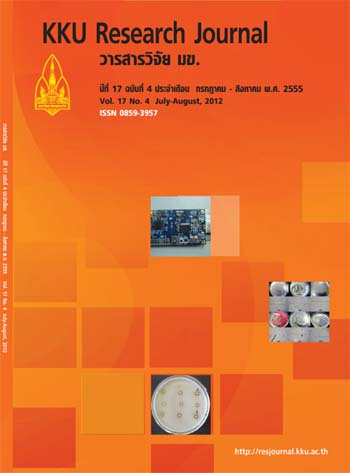Screening and environmental factors effecting on growth of heparinase-producing bacteria
Main Article Content
Abstract
Heparinases are heparin-degrading enzymes that eliminatively cleave certain sequences of heparin/heparan sulfate specifically. Heparinases offer therapeutic and diagnostic applications such as heparin detection and affect reversal. In addition, they have been employed in preparation of Low-Molecular-Weight heparin (LMWH) possessing high efficiency than unfractionated heparin (UFH). Novel heparinase-producing microorganisms can lead to an elevated efficiency and effective production including innovative application. In this research, four (RYA En1, RYB En1, RYA HT1 and RYA HT1) and two (SKA En1 and SKA HT1) heparinase-producing bacteria were isolated from brackish sediment samples located at Krached canal in Rayong province and from marine sediment samples located at Don Hoy Lod in Samut Songkhram province, respectively. All heparinase-producing isolates are gram-negative, non-spore forming rod shape bacteria, positive for catalase test, negative for indole production and gelatin hydrolysis tests, and gave positive result for preliminary simple heparinase-producing detection via metachromatic reaction using Toluidine method. The isolated bacteria were capable of degrading more than 90% (w/w) of heparin containing in the culture medium at 24 hours of cultivation with 3.75 U L-1 h-1 of heparinase. Furthermore, these isolates were examined for intracellular constitutive heparinase that released from the periplasmic space by Azure A assay and it was found that the highest heparinase specific activity of RYA En1 at 82 U mg-1 was achieved. According to the cultivation conditions, optimal temperatures for growth of these isolates were 25-30 °C except RYA HT1 and SKA En1 that were able to grow at 40 °C. Corresponding to the sediment sources, RYA HT1, RYA En1 and RYB En1 were able to grow in media containing 0-5% (w/v) NaCl whereas SKA HT1, SKA EN1 and RYA HT1 were capable to grow at 10% (w/v) NaCl. The optimal pH for growth of most isolates ranged from 5-10.
Article Details
How to Cite
Pulsawat, W., & Khanitchaidecha, P. (2017). Screening and environmental factors effecting on growth of heparinase-producing bacteria. Asia-Pacific Journal of Science and Technology, 17(4), 593–606. retrieved from https://so01.tci-thaijo.org/index.php/APST/article/view/83271
Section
Research Articles


